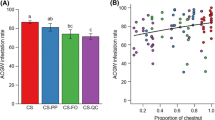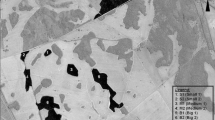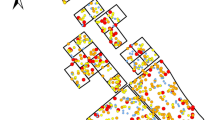Summary
The insect complex colonizing white fir (Abies concolor [Gord. and Glend.] Lindl.) cones is composed of eleven species that can be separated into three feeding guilds: the seed-mining guild, Megastigmus pinus Parfitt, M. rafni Hoffmeyer, Earomyia abietum McAlpine; the cone-and seed-mining guild, Dioryctria abietivorella Grote, Eucosma prob. siskiyouana (Kearfoot), Cydia prob. bracteatana (Fernald), Barbara sp.; the scale-and bract-feeding guild, Asynapta hokinsi (Felt), Dasineura prob. abiesemia Foote, Ressiliella conicola (Foote), Lasiomma abietis Huckett). In three of four study sites the cone crop decreased from one year to the next. As cone crop size decreased there was a concomitant increase in the percent of cones with more than one species. In addition, there was a shift toward an increased co-occurrence of members of different guilds within a single cone. Both positive and negative interactions were detected between selected species-pairs. Present-day competition was only inferred between species-pairs belonging to the cone and seed-mining guild. Decreasing resources over time, combined with increasing insect populations and the absence of acceptable alternate hosts appeared to be important factors for setting conditions conducive to interspecific competition. It is hypothesized, that the aperiodicity of white fir cone crops was important in keeping insect populations below levels which would result in interspecific competition. The possible elimination of aperiodicity in cone crops of white fir, such as might occur in managed seed orchards, may lead to decreased species diversity via competitive exclusion and thereby simplify development of IPM programs.
Similar content being viewed by others
References
Begon M, Harper JL, Townsend CR (1986) Ecology. Individuals, populations, and communities. Sinauer Assoc Mc Sunderland, Massachusetts, pp 876
Connell JH (1980) Diversity and coevolution of competitors, or the ghost of competition past. Oikos 35:131–138
Connell JH (1983) On the prevalence and relative imprtance of interspecific competition: Evidence from field experiments. Am Nat 122:661–696
Connor EF, Simberloff D (1979) The assembly of species communities: chance or competition? Ecology 60:1132–1140
DeAngelis DL, Waterhouse JC (1987) Equilibrium and nonequilibrium concepts in ecological models. Ecol Monogr 57:1–21
Diamond JM (1983) Laboratory, field, and natural experiments. Nature 304:586–587
Foote RH (1956) Gall midges associated with cones of western forest trees (Diptera: Itonidae). J Wash Acad Sci 46:48–57
Hairston NG, Smith FE, Slobodkin LB (1960) Community structure, population control and competition. Am Nat 44:421–425
Harvey PH, Colwell RK, Silvertown JW, May, RW (1983) Null models in ecology. Annu Rev Ecol Syst 14:189–211
Hastings A (1987) Can competition be detected using species cooccurrence data? Ecology 68:117–123
Hedlin AF, Yates III HO, Tovar DC, Ebel BH, Koerber TW, Merkel EP (1981) Cone and seed insects of Northern American conifers. Can For Serv, US For Serv, Secretaria de Agricultura y Recursos Hidraulicos, Mexico, pp 122
Keen FP (1958) Cone and seed insects of western forest trees. US Dept Agriculture, Forest Service, Tech Bull 1169, pp 168
Lawton JH, Strong DR (1981) Community patterns and competition in folivorous insects. Am Nat 118:317–338
Mattson WJ (1971) Relationship between cone crop size and damage by insects in red pine seed production areas. Can Entomol 103:617–621
Mattson WJ (1986) Competition for food between two principal cone insects of red pine Pinus resinosa. Environ Ent 15:88–92
Miller GE, Hedlin AF, Ruth DS (1984) Damage by two Douglasfir cone and seed insects. J Entomol Soc B C 81:46–50
Root RB (1967) The niche exploitation pattern of the blue-jay gnatcatcher. Ecol Monogr 37:317–350
Roughgarden J (1983) Competition and theory in community ecology. Am Nat 122:583–601
Schoener TW (1974) Resource paritioning in ecological communities. Science 189:27–39
Schoener TW (1983) Field experiments on interspecific competition. Am Nat 122:240–285
Shea PJ (1989) Phytophagous insect complex associated with cones of white fir (Abies concolor [Gord. and Glend.] Lindl.) and its impact on seed production. CanEnt 121:699–708
Toft CA, Shea PJ (1983) Determining communitywide patterns: Estimating power strengthens statistical inference. Am Nat 122:618–625
Toft CA, Trauger DL, Murdy HW (1982) Test for species interactions: Breeding phenology and habitat use in subarctic ducks. Am Nat 120:586–613
Wiens JA (1977) On competition and variable environments. Sci Am 65:590–597
Author information
Authors and Affiliations
Rights and permissions
About this article
Cite this article
Shea, P.J. Interactions among phytophagous insect species colonizing cones of white fir (Abies concolor). Oecologia 81, 104–110 (1989). https://doi.org/10.1007/BF00377018
Received:
Accepted:
Issue Date:
DOI: https://doi.org/10.1007/BF00377018




